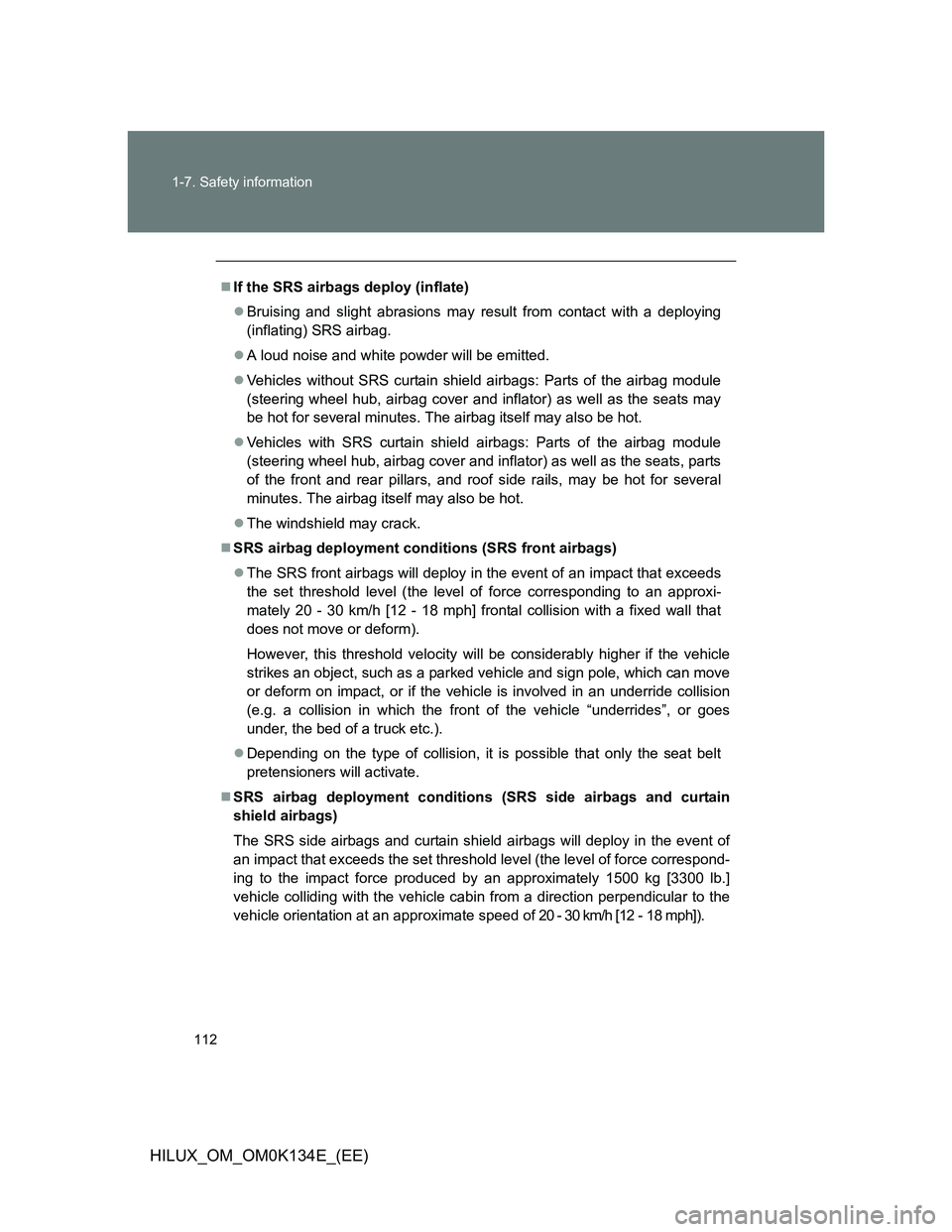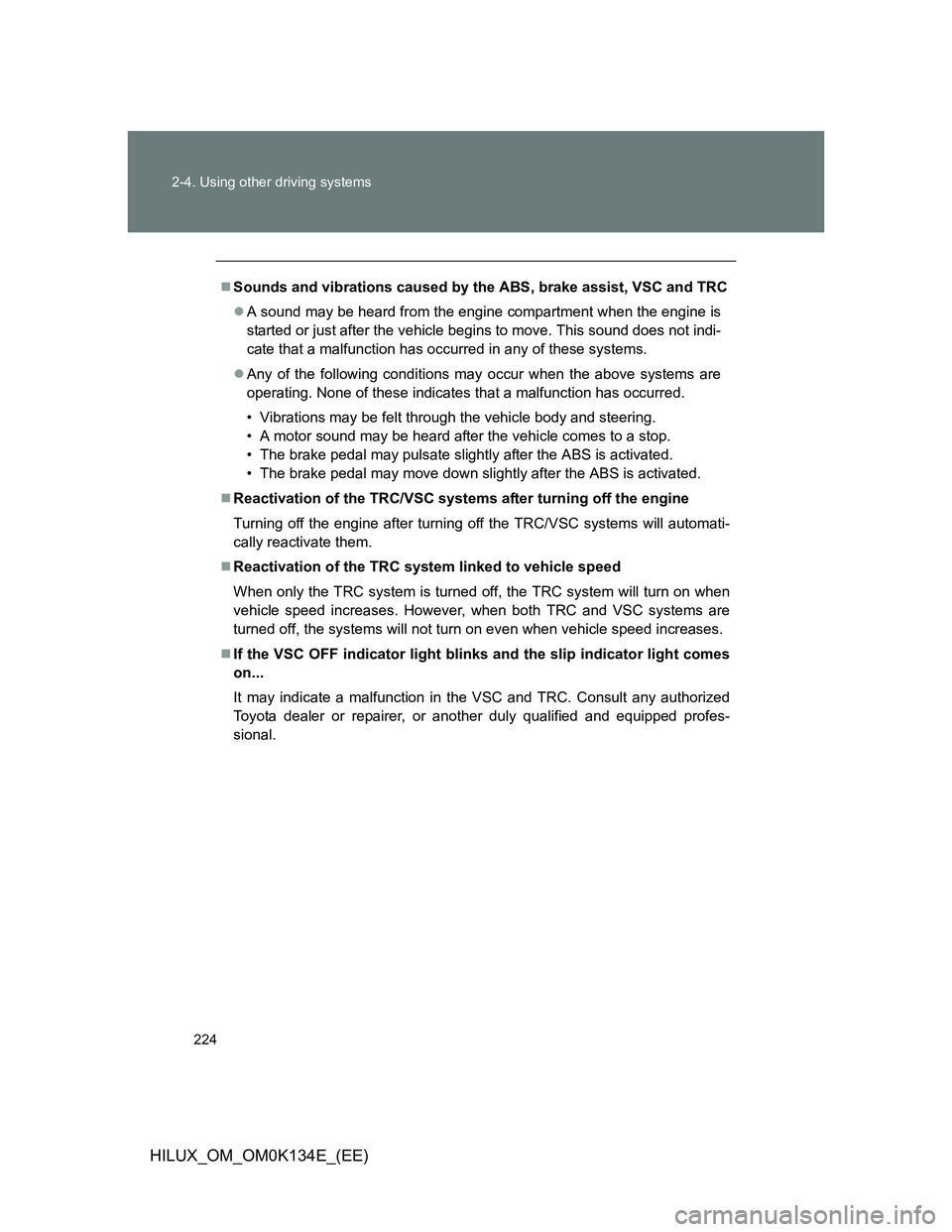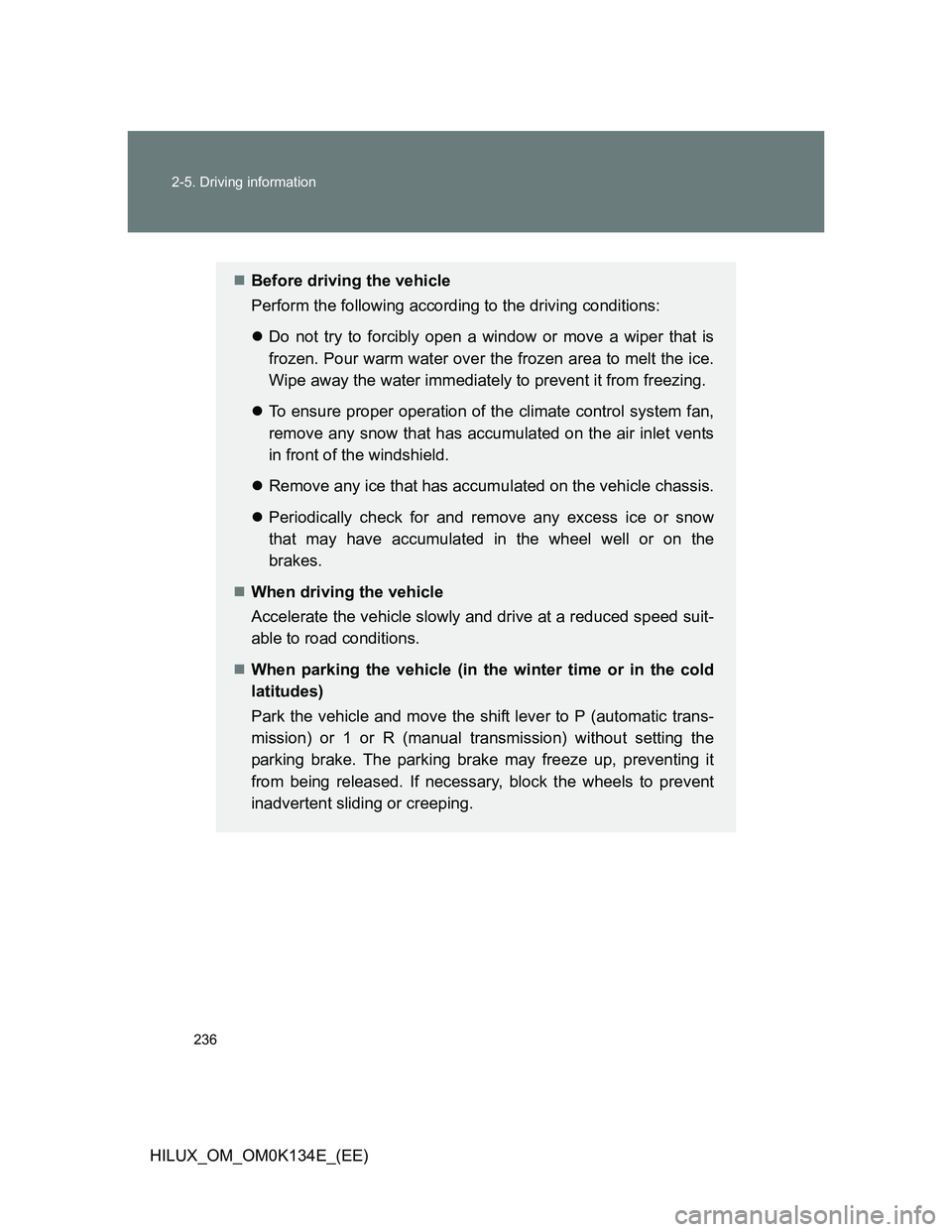Page 112 of 644

112 1-7. Safety information
HILUX_OM_OM0K134E_(EE)
If the SRS airbags deploy (inflate)
Bruising and slight abrasions may result from contact with a deploying
(inflating) SRS airbag.
A loud noise and white powder will be emitted.
Vehicles without SRS curtain shield airbags: Parts of the airbag module
(steering wheel hub, airbag cover and inflator) as well as the seats may
be hot for several minutes. The airbag itself may also be hot.
Vehicles with SRS curtain shield airbags: Parts of the airbag module
(steering wheel hub, airbag cover and inflator) as well as the seats, parts
of the front and rear pillars, and roof side rails, may be hot for several
minutes. The airbag itself may also be hot.
The windshield may crack.
SRS airbag deployment conditions (SRS front airbags)
The SRS front airbags will deploy in the event of an impact that exceeds
the set threshold level (the level of force corresponding to an approxi-
mately 20 - 30 km/h [12 - 18 mph] frontal collision with a fixed wall that
does not move or deform).
However, this threshold velocity will be considerably higher if the vehicle
strikes an object, such as a parked vehicle and sign pole, which can move
or deform on impact, or if the vehicle is involved in an underride collision
(e.g. a collision in which the front of the vehicle “underrides”, or goes
under, the bed of a truck etc.).
Depending on the type of collision, it is possible that only the seat belt
pretensioners will activate.
SRS airbag deployment conditions (SRS side airbags and curtain
shield airbags)
The SRS side airbags and curtain shield airbags will deploy in the event of
an impact that exceeds the set threshold level (the level of force correspond-
ing to the impact force produced by an approximately 1500 kg [3300 lb.]
vehicle colliding with the vehicle cabin from a direction perpendicular to the
vehicle orientation at an approximate speed of 20 - 30 km/h [12 - 18 mph]).
Page 113 of 644
113 1-7. Safety information
1
Before driving
HILUX_OM_OM0K134E_(EE)
Conditions under which the SRS airbags may deploy (inflate), other
than a collision (SRS front airbags)
The SRS front airbags may also deploy if a serious impact occurs to the
underside of your vehicle. Some examples are shown in the illustration.
Types of collisions that may not deploy the SRS airbags (SRS front air-
bags)
The SRS front airbags are generally not designed to inflate if the vehicle is
involved in a side or rear collision, if it rolls over, or if it is involved in a low-
speed frontal collision. But, whenever a collision of any type causes suffi-
cient forward deceleration of the vehicle, deployment of the SRS front air-
bags may occur.
Hitting a curb, edge of pavement or
hard surface
Falling into or jumping over a deep hole
Landing hard or falling
Collision from the side
Collision from the rear
Vehicle rollover
Page 161 of 644
161 2-1. Driving procedures
2
When driving
HILUX_OM_OM0K134E_(EE)
NOTICE
When encountering flooded roads
Do not drive on a road that has flooded after heavy rain etc. Doing so may
cause the following serious damage to the vehicle:
Engine stalling
Short in electrical components
Engine damage caused by water immersion
In the event that you drive on a flooded road and the vehicle is flooded, be
sure to have any authorized Toyota dealer or repairer, or another duly quali-
fied and equipped professional check the following:
Brake function
Changes in quantity and quality of oil and fluid used for the engine, trans-
mission, transfer (4WD models), differential, etc.
Lubricant condition for the propeller shaft, bearings and suspension joints
(where possible), and the function of all joints, bearings, etc.
Page 211 of 644

211 2-4. Using other driving systems
2
When driving
HILUX_OM_OM0K134E_(EE)
CAUTION
Conditions which may affect the rear view monitor system
If the back of the vehicle has been hit, the camera’s position and mounting
angle may have changed. Have the vehicle inspected by any authorized
Toyota dealer or repairer, or another duly qualified and equipped profes-
sional.
Rapid temperature changes, such as when hot water is poured on the
vehicle in cold weather, may cause the system to function abnormally.
If the camera lens is extremely dirty, it cannot transmit a clear image.
Rinse with water and wipe with a soft cloth. If the camera lens is extremely
dirty, wash with a mild cleanser and rinse.
The displayed image may be darker and moving images may be slightly
distorted when the system is cold.
When washing the vehicle, do not apply intensive bursts of water to the
camera or camera area. Doing so may result in the camera malfunction-
ing.
Do not strongly rub the camera lens. If the camera lens is scratched, it
cannot transmit a clear image.
Do not allow organic solvent, car wax, window cleaner or glass coat to
adhere to the camera. If this happens, wipe it off as soon as possible.
As the camera has a water proof construction, do not detach, disassemble
or modify it. This may cause incorrect operation.
Do not subject the camera to a strong impact.
Page 224 of 644

224 2-4. Using other driving systems
HILUX_OM_OM0K134E_(EE)
Sounds and vibrations caused by the ABS, brake assist, VSC and TRC
A sound may be heard from the engine compartment when the engine is
started or just after the vehicle begins to move. This sound does not indi-
cate that a malfunction has occurred in any of these systems.
Any of the following conditions may occur when the above systems are
operating. None of these indicates that a malfunction has occurred.
• Vibrations may be felt through the vehicle body and steering.
• A motor sound may be heard after the vehicle comes to a stop.
• The brake pedal may pulsate slightly after the ABS is activated.
• The brake pedal may move down slightly after the ABS is activated.
Reactivation of the TRC/VSC systems after turning off the engine
Turning off the engine after turning off the TRC/VSC systems will automati-
cally reactivate them.
Reactivation of the TRC system linked to vehicle speed
When only the TRC system is turned off, the TRC system will turn on when
vehicle speed increases. However, when both TRC and VSC systems are
turned off, the systems will not turn on even when vehicle speed increases.
If the VSC OFF indicator light blinks and the slip indicator light comes
on...
It may indicate a malfunction in the VSC and TRC. Consult any authorized
Toyota dealer or repairer, or another duly qualified and equipped profes-
sional.
Page 227 of 644
227
2-4. Using other driving systems
2
When driving
HILUX_OM_OM0K134E_(EE)
DPF (Diesel Particulate Filter) system
DPF system failure warning
Vehicles without the DPF system switch
If the DPF system warning light turns on, drive continuously.
(P. 563)
If the DPF system warning light flashes, have the vehicle inspected
by any authorized Toyota dealer or repairer, or another duly qualified
and equipped professional, immediately. (P. 560)
: If equipped
When the deposit collected by the filter reaches a predetermined
amount, it is automatically regenerated.
Regeneration
Regeneration is performed as necessary in accordance with
driving conditions.
System characteristics
The DPF system has the following characteristics:
Idle speed increases during regeneration
The smell of the exhaust gas differs from that of a conven-
tional diesel vehicle
Page 236 of 644

236 2-5. Driving information
HILUX_OM_OM0K134E_(EE)
Before driving the vehicle
Perform the following according to the driving conditions:
Do not try to forcibly open a window or move a wiper that is
frozen. Pour warm water over the frozen area to melt the ice.
Wipe away the water immediately to prevent it from freezing.
To ensure proper operation of the climate control system fan,
remove any snow that has accumulated on the air inlet vents
in front of the windshield.
Remove any ice that has accumulated on the vehicle chassis.
Periodically check for and remove any excess ice or snow
that may have accumulated in the wheel well or on the
brakes.
When driving the vehicle
Accelerate the vehicle slowly and drive at a reduced speed suit-
able to road conditions.
When parking the vehicle (in the winter time or in the cold
latitudes)
Park the vehicle and move the shift lever to P (automatic trans-
mission) or 1 or R (manual transmission) without setting the
parking brake. The parking brake may freeze up, preventing it
from being released. If necessary, block the wheels to prevent
inadvertent sliding or creeping.
Page 248 of 644

248 2-5. Driving information
HILUX_OM_OM0K134E_(EE)If the engine overheats
Towing a loaded trailer up a long, steep incline in temperatures
exceeding 30C (85F) may result in the engine overheating. If the
engine coolant temperature gauge indicates that the engine is
overheating, turn the air conditioning off immediately, leave the
road and stop the vehicle in a safe place. (P. 592)
When parking the vehicle
Always place wheel chocks under the wheels of both the vehicle
and trailer. Firmly set the parking brake and shift the shift lever to P
for automatic transmissions, and 1 or R for manual transmissions.
CAUTION
Follow all the precautions described in this section. Failure to do so could
cause an accident resulting in death or serious injury.
Trailer towing precautions
When towing, make sure that none of the weight limits are exceeded.
(P. 240)
Vehicle speed in towing
Observe the legal maximum speeds for trailer towing.
Before descending hills or long declines
Reduce speed and downshift. However, never downshift suddenly while
descending steep or long down hill grades.
Operation of the brake pedal
Do not hold the brake pedal depressed often or for long periods of time.
Doing so may result in the brake overheating or reduce braking effects.